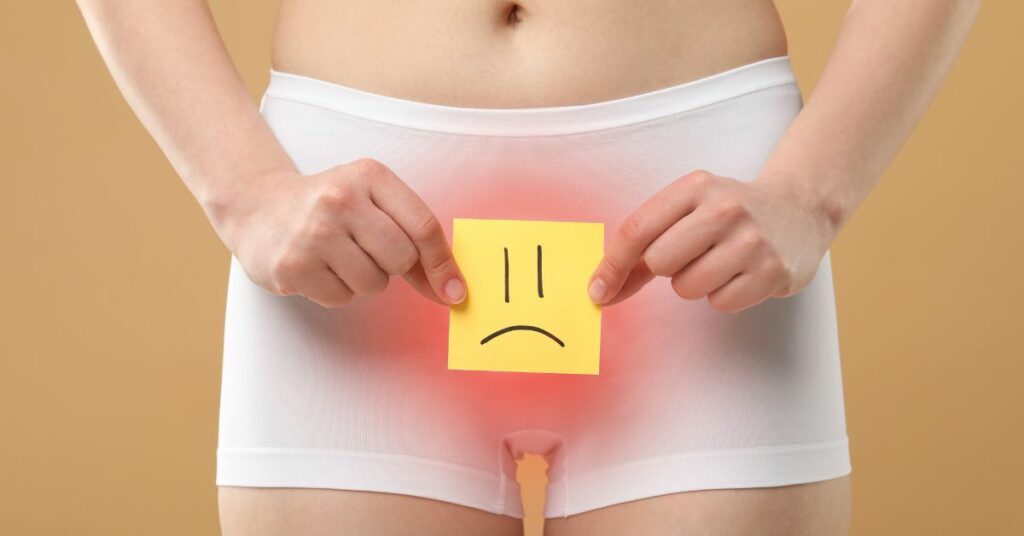Cystitis is a common and often painful condition that affects millions of people, especially women, around the world. It is characterised by inflammation of the bladder and can cause symptoms such as frequent urination, a burning sensation during urination, and lower abdominal pain. If left untreated, cystitis can lead to more serious complications, making it crucial to understand its causes, symptoms, and treatment options.
In this comprehensive guide, we will delve into the world of cystitis and uncover everything you need to know. From the factors that contribute to its development, including bacterial infections and certain lifestyle habits, to the ways it manifests itself in the body, we’ll explore the ins and outs of this condition.
Furthermore, we will explore the various treatment options available for cystitis, ranging from self-care measures to medication and remedies recommended by our Wellness Pharmacists at The Health Dispensary. Whether you are looking for ways to prevent cystitis or seeking relief from its symptoms, we hope this article becomes your ultimate resource.
So, let’s dive in and discover all there is to know about cystitis so you can take control of your health and wellness.
Causes of cystitis
Cystitis is a common condition that can arise due to a variety of factors. One of the primary causes of cystitis is a bacterial infection in the urinary tract. The most common culprit is the Escherichia coli (E. coli) bacteria, which normally resides in the gastrointestinal tract but can sometimes make its way into the urinary tract, leading to an infection.
Another potential cause of cystitis is an inflammatory response in the bladder, which can be triggered by certain irritants or factors. This type of cystitis, known as interstitial cystitis or painful bladder syndrome, is not caused by a bacterial infection but rather by chronic inflammation and pelvic pain. Interstitial cystitis can be challenging to diagnose and treat, as the underlying causes are not fully understood.
In some cases, cystitis can also be caused by a sexually transmitted infection (STI), such as chlamydia or gonorrhoea. These infections can lead to inflammation and irritation in the urinary tract, resulting in cystitis-like symptoms. Additionally, certain medical conditions, such as diabetes or an enlarged prostate in men, can increase the risk of developing cystitis by affecting the function of the urinary tract.
Risk factors for developing cystitis
One of the primary risk factors for developing cystitis is being female! Women have a shorter urethra than men, making it easier for bacteria to enter the bladder and cause an infection. Additionally, the female anatomy places the urethra in closer proximity to the rectum, increasing the risk of bacterial migration from the gastrointestinal tract.
Sexual activity can also be a risk factor for cystitis, particularly in women. During sexual intercourse, bacteria can be introduced into the urinary tract, leading to an infection. Using certain types of birth control, such as diaphragms or spermicides, can also increase the risk of cystitis in some women.
Certain lifestyle factors, such as poor hygiene, can also contribute to the development of cystitis. Wiping from back to front after using the bathroom, for example, can introduce bacteria into the urinary tract. Additionally, wearing tight, restrictive clothing or using scented feminine products can irritate the delicate tissues in the urinary tract, making them more susceptible to infection.
Underlying medical conditions, such as diabetes or a weakened immune system, can also increase the risk of cystitis. Diabetes can impair the body’s ability to fight off infections, while a weakened immune system can make an individual more susceptible to bacterial infections in the urinary tract. Pregnancy and menopause can also be risk factors for cystitis, as hormonal changes can affect the health of the urinary tract.
Common symptoms of cystitis
The most common symptom of cystitis is a burning or stinging sensation during urination, known as dysuria. This discomfort is often accompanied by a frequent and urgent need to urinate, even when the bladder is not full. Patients with cystitis may also experience pain or pressure in the lower abdomen or pelvic area, as well as a feeling of incomplete bladder emptying.
In some cases, individuals with cystitis may also notice changes in the appearance or odour of their urine. The urine may appear cloudy, bloody, or have a strong, unpleasant smell, which can indicate an underlying infection or inflammation in the urinary tract.
Depending on the underlying cause, cystitis can also be accompanied by other symptoms, such as fever, chills, or back pain. In cases of interstitial cystitis or painful bladder syndrome, patients may experience chronic pelvic pain and discomfort that is not relieved by urination.
It’s important to note that the severity and duration of cystitis symptoms can vary widely from person to person. Some individuals may experience only mild discomfort, while others may have more severe and debilitating symptoms that significantly impact their quality of life. Seeking medical attention is crucial, as untreated cystitis can lead to more serious complications, such as kidney infections or chronic bladder problems.

Diagnosis of cystitis
Diagnosing cystitis typically involves a consultation with your healthcare provider. This may be your regular GP or, more commonly, a Pharmacist or Prescribing Pharmacist who will ask about your symptoms, medical history, and any potential risk factors or triggers for your condition.
For more complex or frequent cases of cystitis or where the cause is unclear your healthcare provider may order one or more of the following tests:
- Urinalysis: This simple test involves analyzing a sample of your urine to check for the presence of white blood cells, red blood cells, bacteria, or other signs of infection or inflammation.
- Urine culture: A urine culture can identify the specific bacteria causing the infection, which can help guide the appropriate treatment.
- Cystoscopy: In some cases, your healthcare provider may recommend a cystoscopy, which involves inserting a small, flexible camera into the urethra to examine the bladder and identify any underlying issues.
- Imaging tests: Depending on your symptoms and medical history, your healthcare provider may order imaging tests, such as an ultrasound or CT scan, to rule out other potential causes of your symptoms.
Accurate diagnosis is crucial for effective treatment, as the underlying cause of cystitis can vary. Our Pharamcists will know when referral to your GP or urgent care is needed. By working closely with your healthcare providers and undergoing the appropriate tests, you can ensure that your condition is properly identified and addressed.
Treatment options for cystitis
The treatment approach for cystitis will depend on the underlying cause of the condition, the severity of the symptoms, and any underlying medical conditions the patient may have. In many cases, the first line of treatment involves a combination of self-care measures and medication.
For bacterial cystitis, the primary treatment is typically a course of antibiotics prescribed by a healthcare provider. The specific antibiotic and duration of treatment will depend on factors such as the type of bacteria causing the infection, the severity of the symptoms, and any previous antibiotic use.
In addition to antibiotics, over-the-counter pain medications, such as ibuprofen or paracetamol, can help alleviate the discomfort and pain associated with cystitis. Drinking plenty of water and avoiding bladder irritants, such as caffeine, fizzy drinks and alcohol, can also help promote healing and prevent further complications.
For individuals with interstitial cystitis or painful bladder syndrome, the treatment approach may involve a combination of lifestyle modifications, medication, and other therapies. This can include dietary changes, bladder training exercises, and the use of medications that help reduce inflammation and pain, such as oral antihistamines or tricyclic antidepressants.
In more severe or persistent cases of cystitis, healthcare providers may recommend more advanced treatment options, such as:
- Bladder instillations: This involves instilling a solution, such as dimethyl sulfoxide (DMSO) or heparin, directly into the bladder to help reduce inflammation and pain.
- Nerve stimulation: Techniques like sacral nerve stimulation or percutaneous tibial nerve stimulation can help manage the symptoms of interstitial cystitis by targeting the nerves that control bladder function.
- Surgery: In rare cases, when other treatments have been unsuccessful, surgery, such as bladder augmentation or removal, may be considered to help alleviate the symptoms of cystitis.
It’s important to work closely with your healthcare providers to develop a personalised treatment plan that addresses the underlying cause of your cystitis and provides the most effective relief for your symptoms.
Preventative measures for cystitis
While cystitis can be a frustrating and recurring condition, there are several preventive measures that individuals can take to reduce their risk of developing the condition or experiencing recurrent episodes.
One of the most important preventive measures is maintaining good personal hygiene. This includes wiping from front to back after using the bathroom, avoiding the use of scented feminine products, and wearing loose, breathable clothing. Regularly urinating and avoiding holding in urine can also help flush out bacteria and prevent the development of an infection.
Certain lifestyle changes can also help reduce the risk of cystitis for women. These include avoiding the use of spermicides or diaphragms, which can irritate the delicate tissues of the urinary tract, and urinating after sexual activity to help flush out any bacteria that may have been introduced. Additionally, maintaining a healthy weight and staying hydrated can also contribute to a lower risk of cystitis.
For individuals with underlying medical conditions, such as diabetes or a weakened immune system, managing these conditions effectively can also help prevent the development of cystitis. This may involve taking medication as prescribed, maintaining a healthy lifestyle, and regularly monitoring any changes in symptoms or health status.
In some cases, healthcare providers may also recommend prophylactic (preventive) antibiotic treatment for individuals who experience recurrent episodes of cystitis. This can involve taking a low-dose antibiotic on a regular basis to help prevent the development of future infections.
By implementing these preventive measures and working closely with healthcare providers, individuals can actively reduce their risk of developing cystitis and maintain a healthy urinary tract.

Natural remedies for cystitis
While traditional medical treatments, such as antibiotics and pain medications, are often the first line of defence against cystitis, many individuals also turn to natural remedies to help alleviate their symptoms and support the healing process.
One of the most commonly recommended natural remedies for cystitis is cranberry juice or supplements. Cranberries contain compounds that can help prevent bacteria from adhering to the walls of the urinary tract, potentially reducing the risk of infection. However, it’s important to note that the effectiveness of cranberry products for treating cystitis is still a subject of ongoing research, and results may vary from person to person.
Another natural remedy that has gained attention for its potential benefits in managing cystitis is D-mannose, a type of sugar that is found in some fruits and vegetables. D-mannose is believed to work by preventing bacteria from attaching to the bladder wall, thus reducing the risk of infection. While more research is needed, some studies have suggested that D-mannose may be a useful supplement for individuals with recurrent urinary tract infections.
In addition to dietary supplements, certain herbs and essential oils have also been explored for their potential to alleviate cystitis symptoms. For example, some individuals have found relief from the use of soothing herbs like marshmallow root, uva ursi, or goldenseal, which may have anti-inflammatory and antimicrobial properties. Essential oils, such as tea tree oil or lavender oil, have also been used topically or in baths to help reduce discomfort and promote healing.
It’s important to note that while these natural remedies may provide some relief for individuals with cystitis, they should not be used as a substitute for traditional medical treatment, especially in cases of severe or recurrent infections. Always consult with a healthcare provider before incorporating any new supplements or natural therapies into your cystitis management plan.
When to seek medical attention for cystitis
While many cases of cystitis can be managed with self-care measures and over-the-counter treatments, there are certain situations when seeking medical attention from a healthcare provider is crucial.
If you are experiencing any of the following symptoms, it is important to consult with a healthcare provider or Call 111 as soon as possible:
- Severe or persistent pain or discomfort in the lower abdomen or pelvic area
- Fever, chills, or other signs of a systemic infection
- Recurrent episodes of cystitis, especially if they occur more than twice within a six-month period
It is also important to seek medical attention if you are experiencing cystitis and are pregnant, have a weakened immune system, or have a history of kidney problems or other underlying medical conditions. These individuals may be at a higher risk of developing more serious complications, such as a kidney infection (pyelonephritis), and may require more intensive treatment.
By seeking prompt medical attention for cystitis, you can help prevent the condition from worsening and reduce the risk of developing more serious complications. Your healthcare provider can work with you to identify the underlying cause of your cystitis and develop a personalised treatment plan to provide relief and promote long-term bladder health.
Conclusion: Living with cystitis and managing the condition
Cystitis is a common and often frustrating condition that can have a significant impact on an individual’s quality of life. However, with the right understanding, preventive measures, and treatment strategies, it is possible to manage the condition and maintain good bladder health.
By educating yourself about the causes, symptoms, and risk factors associated with cystitis, you can take proactive steps to reduce your risk of developing the condition or experiencing recurrent episodes. This may involve implementing lifestyle changes, such as maintaining good personal hygiene, staying hydrated, and avoiding potential irritants.
When cystitis does occur, it is important to work closely with your healthcare provider to ensure that the underlying cause is properly identified and addressed. This may involve a combination of self-care measures, medication, and, in some cases, more advanced treatments. By following the recommended treatment plan and being vigilant about any changes in your symptoms, you can help alleviate the discomfort and prevent the condition from worsening.
For individuals with chronic or recurrent cystitis, managing the condition may require a more comprehensive approach involving a combination of medical treatment, lifestyle modifications, and potentially even psychological support.
Remember, cystitis is a common condition, and you are not alone in your journey. By staying informed, proactive, and open to working with your healthcare providers, you can take control of your bladder health and find the relief and support you need to live a fulfilling life. We are here at The Health Dispensary to offer advice, clinical services and support to help you achieve this.


